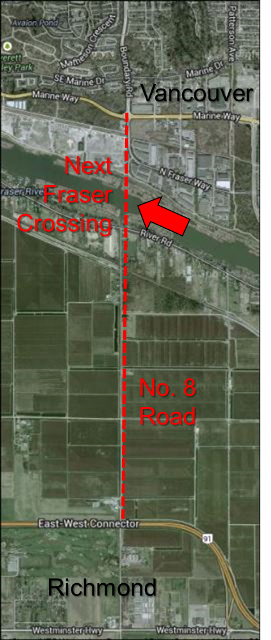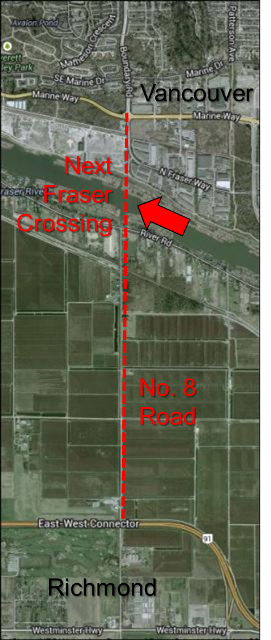In an op-ed in The Sun, Keith Sashaw, the president and CEO of the Association of Consulting Engineering Companies of BC, explains why the status quo (is) not an option for (the) George Massey Tunnel.
There are three characteristics of columns like these:
(1) “Transportation infrastructure is important.” It’s what you’d expect from the representative of those who build transportation infrastructure – and he’s correct.
(2) It’s not just about vehicles. “There are also tremendous opportunities to improve transit as well as pedestrian and cyclist mobility.” Those who build big roads always mention how good it would be for transit. They never mention that transit would not be funded as part of the project.
(3) Thirdly – and this is really the most important thing – it promotes the Next Big Project.
… any additional capacity on the South Arm should be undertaken with consideration to dealing with additional crossings on the North Arm of the Fraser River. (There is) considerable interest in keeping the existing tunnel and twinning it with a new bridge.
It was suggested that the existing tunnel could be a core-collector/distributor system distributing local traffic, and the new bridge could then be the core system for longer distance travel. This would require an additional North Arm crossing at either Knight Street or at Boundary, especially if a new bridge was linked to Number 8 Road. (Right, click to enlarge. Map here.)
Motordom must be fed. The world’s biggest industries – energy, vehicle manufacturing, road building – need a constant infusion of multi-billion-dollar projects to literally keep the wheels rolling. And it needs to have them in the pipeline years before the current projects are finished.
… it is clear that we do need to discuss all options and start planning now if we are to address efficient transportation in BC. ACEC-BC and our member firms are here to engage in this discussion.
But by the time the debate starts on whether we really need or can afford another major piece of Motordom, it’s already been green-lighted and budgeted by the senior decision-makers. Jobs and the economy, it will be said, require it. And if your economy is based on the assumptions of Motordom, well, that’s correct too.













“One key issue that will need to be discussed robustly is that of tolling specific projects such as this versus the adoption of a regional road pricing strategy, as clearly we need to ensure the financial capacity for these changes.” — A ‘robust’ solution might be for “ACEC-BC and our member firms” to front at least half of the cost to build, and then be reimbursed on the basis of tolling– for all modes of transport.
I think this needs to be addressed, but there is no doubt in my mind that the best way to do this is through gas taxes due to the low overhead.
Tesla’s S models, Nissan Leafs and Chevy Volts clog the road too, and with more e-cars and more and more fuel efficient or hybrid cars road tolls at key choke points (say tunnels, bridges or major intersections) are the only meaningful way to reduce congestion coupled with RAPID transit as an alternative (and not more buses). Gasoline taxes are OK for long distances but insufficient for inner-city driving where distances are short.
I bet if every bridge or tunnel in Metrovan were $10 in rush hour and $5 outside of rush hour we would have dozens of subways financed in no time. Where is the political will to do that ? Where is this vision ? Until then, the bus based “decongestion” plan will fail even if gasoline is taxed higher.
Higher gasoline taxes and more (slow) buses as an alternative will not get enough people to switch from car use, only far more dramatic moves and more rapid alternatives.
One key point in the MOT study for the Boundary/8th Corridor/Tilbury bridges is that this will actually reduce the amount of vehicle km travelled due to path efficiency. I believe that stat was roughly 2M km per annum.
Build it, and toll it to keep volumes from cascading out of control and pay off the infrastructure. Who wouldn’t pay $5 bucks in tolls to avoid potentially 28km of driving if you want to go from Tilbury to the Boundary Corridor? Heck, an average car would cost more like $10 to drive that far once everything is factored in.
The biggest downside I can see is that there is a significant chance that traffic going from the 1 along Boundary won’t be addressed properly. A cut and cover/trench tunnel from South of Kingsway to the Central Valley would likely be the best long term solution in my opinion. The right of way is pretty wide which would allow for staged construction.
Perception is more powerful than fact. Nobody thinks that driving the extra distance costs them $10. They see the extra time and might think about the extra gasoline, but that’s it. The marginal cost of an extra km is, in the mind of most drivers, negligible.
When put against the total cost of car ownership the cost to use it really is negligible. $20,000-60,000 up front, $2000 annually to insure, toss in some oil changes and tire rotation and that $60 to fill the tank is a minuscule number that’s not even noticed on your credit card statement.
Drivers will go far out of their way to avoid obvious costs while completely ignoring larger hidden costs. They won’t pay the $5 toll because they don’t realize or accept that avoiding it costs $10.
Well, too bad for those people . I know that cheapest car I can would want to buy costs about $0.32/km to run over its lifetime (Chevy Volt). More people should remove their heads from the butts.
If people want to waste money sitting in traffic and leave infrastructure available for my use, then all the better. At least it would be there when I need it.
As long as it’s self funded via tolls what’s the problem? It would be one of the few pieces of any kind of infrastructure that actually would be.
There is more to transportation systems than capital investments. They have an impact on many components of our daily lives: land use, air quality, health, economic efficiency, etc.
I am not a freeway promoter, but I believe in extra redundancies that disperse traffic onto the grid more effectively. The catch is two fold, one the new infrastructure should not contribute to new car trips so must be tolled appropriately and second since money is limited it must be fairly (including health and wellness etc) be assessed for a return on investment relative to other projects including transit (obviously with the best R.O.I. going first). That said twinning the tunnel does not really add extra redundancies because it is just the same crossing only with more lanes. A crossing at Boundary would be an extra redundancy but I am not sure if it could be justified on its own (would enough people currently taking Oak or Queensbourgh pay a toll to cross at Boundary?). The same could be said for the Patullo options the most expensive option a new crossing location would create new options and disperse some of the traffic and give additional options
How much would high-capacity transit options (plus better cycling facilities for last kms) costs in relation to the tunnelling, bridging not to mention the extra car lanes required in Vancouver and parking lots all over the lower mainland that this type of car infrastructure ‘induces’?
Rico spoke of dispersing traffic through the grid,which is a good point and relevant to ‘highways in cities’ considerations of the 20th C, but what about attracting more people to live and work on transit corridors which are part of an integrated network for the 21st C?